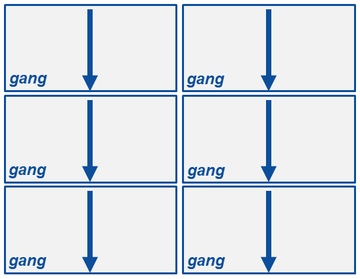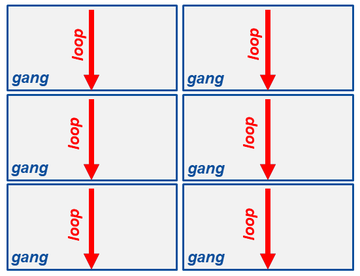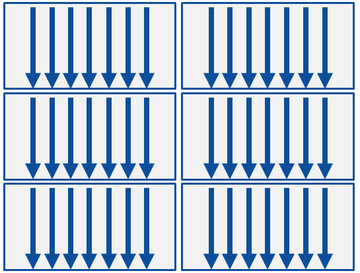« Previous 1 2 3 4 Next »
Parallelizing Code – Loops
OpenACC Introduction
OpenACC has a number of directives that can be put into code that give the compiler information about how you would like to parallelize the code. The general form of the syntax is shown in Table 1, but before getting too deep into directives, I’ll look at what is happening in the code with the parallel directive.
Table 1: Parallelizing Fortran and C
| Fortran | C |
!$acc <directive clauses> < code > |
#pragma acc <directive clauses> < code > |
The parallel directive is a way to express parallelism in your code. Table 2 is a very simple example of getting started with directives in both Fortran and C.
Table 2: parallel Directive
| Fortran | C |
!$acc parallel < parallel code > !$acc end parallel |
#pragma acc parallel
{
< parallel code >
}
|
The directives for Fortran and C begin with comment characters in their respective languages so that a non-OpenACC compiler will ignore them.
In Fortran, immediately after the comment (!) is $acc, which informs the compiler that everything that follows is an OpenACC directive. In C, immediately after the comment (#) is pragma, informing the compiler that some sort of directive follows. After pragma, the acc tells the compiler that everything after it is an OpenACC directive. Inserting directives is pretty straightforward. The only piece of advice is not to forget the $ before acc in Fortran or the #pragma before acc in C.
One of the neat things about OpenACC is that directives can be added incrementally. You should always start with working serial code (with or without MPI); then, you can start adding OpenACC directives to explore parallelism. Along with working serial code, you absolutely need a way to verify whether the output from the application is correct. If the output is verified as correct, then you can annotate more of the code with directives.
Annotating code is a process. You may find occasions when adding a directive will cause the code to slow down. Do not worry. As you continue studying your code and annotating it, you will find the reasons for slowdowns and be able to correct them. This happens frequently when code written for GPU machines (because of the need to move memory between the CPU and the GPU) is fixed as you add directives incremently.
OpenACC parallel and loop Directives
A key to understanding OpenACC is understanding what happens when a parallel directive is encountered. This explanation will extend to other OpenACC clauses, as well.
When the compiler encounters a parallel directive, it generates one or more parallel gangs. In the case of OpenACC on a CPU-only system, a gang will have a single thread and, most likely, one thread per core (unless the processor supports simultaneous multithreading [SMT]). On a GPU, a gang is a collection of processing elements (threads) that can number into the hundreds. These gangs, unless told otherwise, will execute the code redundantly. That is, each gang executes the exact same code (Figure 1). Processing proceeds from the top down for each gang.
Inside the parallel directive, if you have a loop as shown in Table 3, each gang will execute each loop redundantly (i.e., each gang will run the exact same code). These gangs are executed at the same time but independently of one another (Figure 2).
Table 3: Gang Execution
| Fortran | C |
!$acc parallel do i=1,n ! do something enddo !$acc end parallel |
#pragma acc parallel
{
for (int i=0; i < n; i++)
{
# do something
}
}
|
Having each gang compute the exact same thing is not an efficient use of resources. Adding a loop directive to the code (Table 4) tells the compiler that the loop code can be run in parallel across the gangs.
Table 4: loop Directive
| Fortran | C |
!$acc parallel !$acc loop do i=1,n a(i) = 0.0 enddo !$acc end parallel |
#pragma acc parallel
{
#pragma acc loop
for (int i=0; i < n; i++)
{
a[i] = 0.0
}
}
|
When the compiler encounters the parallel directive, it gets ready to create parallelized code and loops for OpenACC parallelization directives by informing the compiler which loops to parallelize. In the above code, it encounters the loop code and creates parallelized code that is split across the gangs or threads as evenly as possible.
Adding only two lines to the code tells the compiler that you have a parallel region and a loop that can be parallelized. That is all you have to do. At this point, the compiler determines how best to parallelize the loop given the target processor architecture. This is the power of OpenACC.
Notice in Figure 3 that each gang runs a number of threads. All of this parallelization is created by the compiler using the directives in the code. A best practice is to combine parallel and loop in one directive covering the loops that are to be optimized.
Because in OpenACC the compiler uses the directives to parallelize the code, it will have a difficult time parallelizing if (1) the loop can’t be parallelized or (2) you don’t give it enough information to make a decision about parallelizing a loop. The compiler implementing the OpenACC standard should err on the side of caution and not try to parallelize a loop if it detects problems or if it is not sure.
If you have code with a loop that the compiler cannot parallelize (e.g., Listing 1), you might see compiler output like:
437, Complex loop carried dependence of e_k prevents parallelization Loop carried reuse of e_k prevents parallelization
Listing 1: Unparallelizable Code
do k=1,9 e_k(1) = real(e((k-1)*2+1)) e_k(2) = real(e((k-1)*2+2)) DP = e_k(1)*U_x(i,j) + e_k(2)*U_y(i,j) f_eq = w(k)*rho(i,j)*(1.0+3.0*DP+(9.0/2.0)*(DP**2.0)-(3.0/2.0)*DPU) f(i,j,k)=f(i,j,k)-(1.0/tau)*(f(i,j,k)-f_eq) enddo
Although it is a very small loop of seven lines, it illustrates data dependencies that can cause the compiler to refuse to parallelize the loop(s).
« Previous 1 2 3 4 Next »



